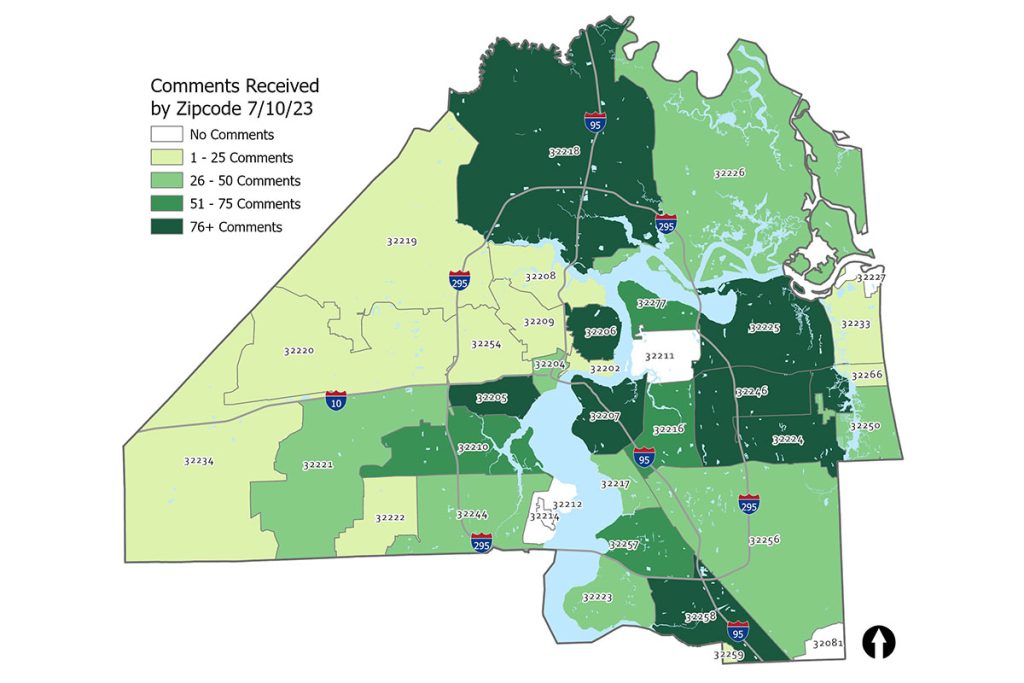20 is Plenty Initiative Urges Drivers to Slow Down in Neighborhoods
Posted on August 1, 2023 By Editor Top Stories

The push for lower speed limits on residential streets continues to be a prevalent issue for Jacksonville, and safety concerns remain high as the city consistently ranks in the top 10 most dangerous cities for pedestrians.
Mayor Donna Deegan’s proposed 2023-2024 budget allocated $13.6 million for sidewalk and crosswalk improvements.
“There’s no reason that Jacksonville should be in the top ten cities for pedestrian fatalities every year,” she said during her budget presentation at a special City Council meeting last month.Beyond sidewalk and crosswalk improvements, however, other efforts can be made to create a safer environment for pedestrians and cyclists on Jacksonville roads. Lowering the speed limit from 30 mph to 20 mph has been an initiative several neighborhoods have spearheaded to promote calmer traffic on their streets.
Over the years, The Resident News has reported on several neighborhoods pursuing speed reductions, including River Road (2015), London, Gadsden, Morvenwood, Greenridge and Mapleton roads (2018), River Oaks Road (2018) and Ardsley Road (2019).
The dangers pedestrians and bicyclists face on the roads are a problem, but not everyone feels that speed reduction is the solution.
Avondale resident Pamela Telis wonders how many drivers would adhere to a lower speed limit when some drivers already disregard the 30 mph speed limit and is concerned that lowering the speed limit might increase risky interactions between speed limit-abiding drivers and speeders.
“To me, it’s already a dangerous situation where people want to drive even faster than 30,” she said. “So, now we’re going to do 20, for example, and the difference between what people want to drive and 20 is even more dangerous, more dangerously different so we’re going to have even more angry people driving on the streets. When you even try to go 30, they’re angry.”
Telis also brings into question the matter of enforcement, which she believes is a key component to reducing the dangers on the road that already exist at the current residential speed limit.
“I don’t know what the solution is, except – like I said – enforcement,” she said. “Lowering the speed limit, to me, is a big mistake.”
Whether it’s speed reduction or traffic-calming devices like speed humps, something must be done to protect everyone on the road.
Last year, a pilot study to monitor drivers’ speed and behavior in reduced speed zones was conducted in Lakewood last August, during which 30 mph speed limit signs within the designated area were swapped for 20 mph signs.
An executive summary of the study stated that the new speed limit signs “did not statistically change or reduce vehicle speeds.”
“When I found out that other pilot program was not, according to them, successful in changing behaviors, we just kind of dropped it,” City Council Member Matt Carlucci said. “I think this might be a good time to reinitiate an effort on it because the new administration has made pedestrian safety one of their hallmarks.”
Currently, a Citywide Residential Speed Limit Reduction Study is underway as part of the 20 is Plenty program, launched last December.
The study includes a three-minute survey for residents to take, and City of Jacksonville Transportation Planning Division Chief Laurie Santana said the survey has garnered more than 2,000 participants so far, and she urges more residents to complete it before the study wraps toward the end of the year.

According to the Jacksonville 20 is Plenty website, 49 pedestrian and bicycle fatalities were reported last year. Reducing the speed limit in residential areas from 30 to 20 mph lowers the risk of fatality in a pedestrian- or bicycle-involved collision from 40% to 13%.
Santana explained the survey results will help the city identify neighborhoods with the greatest support and need for speed reduction, as rolling out an initiative like this across the city would be a costly project.
“If you think about it, the cost to take down every single speed limit sign and put up all new speed limit signs…that’s a big endeavor because it’s a big city,” she said. “So, we have to find out how much would that cost, and then we also have to look at the crash data and make sure that, if we’re going to do this, we do it in the most important areas first.”
Jacksonville’s older neighborhoods without sidewalks or with narrower streets within the old urban core would likely be an ideal focus area, Carlucci noted.
Santana added this effort to improve pedestrian safety will dovetail nicely with Jacksonville’s
“Vision Zero Action Plan: Targeting Zero Bicycle and Pedestrian Fatalities by 2030 in a Designated Safety Focus City,” for which the city’s Transportation Planning Division was awarded $280,000 in federal grant funding through the U.S. Department of Transportation’s Safe Streets and Roads for All competitive grant program last February.
“[20 is Plenty] will help us to have one more thing in our tool kit to help make our streets safer and less dangerous for the most vulnerable users, which are bicyclists and pedestrians,” she said.
More information, including the survey, is available at www.20isplentyjax.com.
By Michele Leivas
Resident Community News




 (No Ratings Yet)
(No Ratings Yet)





